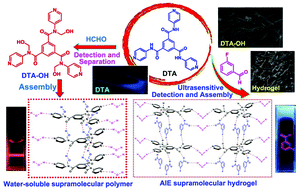Forming a water-soluble supramolecular polymer and an AIEE hydrogel: two novel approaches for highly sensitive detection and efficient adsorption of aldehydes†
Abstract
Herein, we report two novel approaches for highly sensitive detection and efficient adsorption of formaldehyde and 3-fluorobenzaldehyde by forming a water-soluble supramolecular polymer and an aggregation-induced emission enhancement (AIEE) hydrogel, respectively. The host compound DTA could highly selectively and sensitively detect formaldehyde by forming a water-soluble supramolecular polymer in pure water. The LOD of DTA for formaldehyde was 1.79 × 10−8 M. More importantly, DTA could also efficiently adsorb formaldehyde from its water solution, and the adsorption percentage was 98.41%. In addition, DTA could also selectively detect 3-fluorobenzaldehyde from its isomers by forming a supramolecular AIEE hydrogel. The LOD of DTA for 3-fluorobenzaldehyde was 8.87 × 10−9 M; this result reached an ultrasensitive level. These methods are novel and useful approaches for highly sensitive detection and adsorption of aldehydes, as well as new ways for the construction of water-soluble supramolecular polymer materials and hydrogels.



 Please wait while we load your content...
Please wait while we load your content...